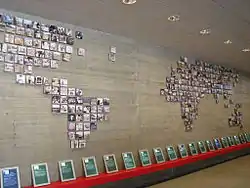Museum of Memory and Human Rights
The Museum of Memory and Human Rights (in Spanish: Museo de la Memoria y los Derechos Humanos) is a Chilean museum located in Santiago, dedicated to commemorate the victims of human rights violations during the civic-military regime led by Augusto Pinochet between 1973 and 1990. It was inaugurated by former President Michelle Bachelet on January 11, 2010 as part of government's commemoration of the bicentennial of Chile.

History

In her speech on May 21, 2007, before the full Congress, President Michelle Bachelet announced the construction of a memorial museum, and a month later she announced a public competition to select an architectural design for it. On August 28 of that year, it was announced that the winning project belonged to a group of Brazilian architects from the office "Estudio America", located in São Paulo. In 2008, a contest to determine who would be in charge of the operation of the museum; "Árbol de Color S. A." was chosen.[1]
The first stone of the Memorial Museum was laid on December 10, 2008 by President Bachelet, who was also a victim of torture during the dictatorship of Pinochet.[2] The materials and documentation for the museum's collection were mostly provided by the organization Casa de la Memoria, whose donations arrived on June 16, 2009 at the La Moneda Palace.[1]
Parallel to the construction of the museum, on December 3, 2009, the museum's board was formed, and on January 6, 2010, Romy Schmidt was appointed as its executive director. Finally, President Bachelet inaugurated the museum on January 11, 2010, two months before finishing her term.
The museum houses torture devices used during the Pinochet dictatorship, letters to family members by prisoners in detention centers, newspaper clippings, and testimony from survivors. The museum also includes a philosophical examination of human rights.[3] Chilean popular icon and folksinger Víctor Jara's last poem, Estadio Chile, written in the moments before his death in the stadium during the 1973 coup, sprawls across the entrance to the museum.[4]
In 2011, the museum added an exposition about Chile’s indigenous peoples.[3] This exhibition is mainly based around photography.[5]
Bachelet’s successor, former president Sebastián Piñera, visited the museum in 2012.[6][7]
In 2012, there was an exhibition by Colombian painter Fernando Botero featuring drawings and paintings about the Abu Ghraib tortures. This was the first international exhibition since 2010.[8]
In 2012, the museum was host to a human rights-themed film festival, with Chilean and international films focusing on the human rights violations in Chile and Argentina. The event also included panels with young filmmakers, students, and social organizations.
In 2012, the museum also declared it would host a memorial for the victims of the group ETA, a Basque country group that seeks independence from Spain for the Basque region that encompasses northern Spain and a part of southern France.[9]
In 2013, the Foundation Museo de la Memoria and the Inter-American Court of Human Rights signed an agreement to established a network of institutions dedicated to this theme. They plan to coordinate investigation, collaboration, and elaboration of human rights. The agreement will result in conferences and seminars held together, as well as interchange of officials, professional practices, research and publication.[10]
Rooms
- Entry Hall
- Room 1: "Human Rights, universal challenge" ("Derechos Humanos, desafío universal")
- Level 1
- Room 2: "Military Coup of September 11, 1973" - Microcinema ("Golpe de Estado del 11 de septiembre de 1973" - Microcine)
- Room 3: "End of the Rule of Law: A new institutionalism" ("Fin del Estado de Derecho. Una nueva institucionalidad")
- Room 4: "International Condemnation: The dictatorship crosses the line" ("Condena Internacional. La dictadura traspasa fronteras")
- Room 5: "Repression and Torture" ("Represión y Tortura")
- Room 6: "The Pain of the Children" ("El Dolor de los Niños")
- Level 2
- Room 7: "A Demand for Truth and Justice" ("Demanda de Verdad y Justicia")
- Room 8: "Absence and Memory" ("Ausencia y Memoria")
- Room 9: "Fight for Freedom" ("Lucha por la libertad")
- Room 10: "Return to Hope" ("Retorno a la esperanza")
- Room 11: "Never Again" ("Nunca Más")
- Level 3
- Expositions
- Coffee shop
See also
- Human rights violations of the Chilean dictatorship
- Forced disappearance
- Human rights in Chile
- List of museums in Chile
References
- Museo de la Memoria. "Historia".
- Bicentenario. "Museo de la Memoria y los Derechos Humanos". Archived from the original on 2010-01-15.
- Chile’s leading human rights museum: the Museo de la Memoria – Chile
- Watts, Jonathan; Franklin, Jonathan (10 September 2013). "Agony of Chile's dark days continues as murdered poet's wife fights for justice". The Guardian. Guardian Media Group. Archived from the original on 5 October 2013. Retrieved 5 October 2013.
- Servindi » Chile: Museo de la memoria inaugura galería con muestra de fotografía indígena | Servicios en Comunicación Intercultural Servindi
- Piñera visita el Museo de la Memoria y habla de la importancia de recordar | Emol.com
- Presidente Piñera recorre Museo de la Memoria – Terra
- Museo de la Memoria trae cruda visión de Botero sobre torturas en Abu Ghraib | Emol.com
- nacion.cl – En Museo de la Memoria de Chile se basará memorial para víctimas de ETA
- Museo de la Memoria y CIDH firman convenio de cooperación mutua « Radio Universidad de Chile – Diario Electrónico
External links
| Wikimedia Commons has media related to Museo de la Memoria y los Derechos Humanos. |
